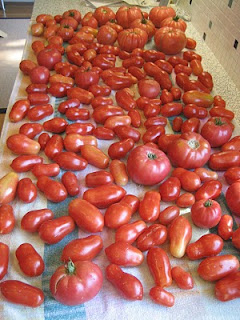
We had a backlog of apples from the box over the last few weeks that we had yet to use. Then a neighbor dropped by with some more homegrown apples. Usually I would make an apple pie in situations like this but I was inspired by this recipe from a fellow CSAer to go for the crisp. I like the idea of incorporating oats instead of just a white flour pie crust. The crisp is a nice, tasty alternative to pie.
As a starting point, I just used the recipe off of the oats box (with a few minor modifications). It says you can also use pears and peaches instead.
Apple Cranberry Crisp
Filling:
- 6 cups of diced apples, peel on (about 6-8 apples)
- 1/2 cup dried cranberries
- 1/3 cup maple syrup (I didn't have any so I used some honey and brown sugar instead)
- 1 tbsp. lemon juice
- 1 tsp. vanilla extract
- 1/2 tsp. ground cinnamon
- 1/4 tsp. ground nutmeg
- 1 cup Quick or Old Fashioned uncooked oats (I used Country Choice available to Trader Joe's)
- 3/4 cup brown sugar
- 1/3 cup flour
- 1 tsp. cinnamon
- 1 tsp. salt
- 1/2 stick of melted butter
- Preheat oven to 375. With a small dab of butter grease the bottom of a glass or ceramic 9 inch pie pan.
- In a large bowl collect the apple pieces, lemon juice, cranberries, syrup, vanilla extract, cinnamon, and nutmeg. Stir until well mixed. Spread evenly into the pie pan.
- Prepare the topping by mixing together the oats, brown sugar, flour, cinnamon, and salt. Add the melted butter and stir until evenly moistened. Spread evenly over the fruit.
- Bake 35-40 minutes or until fruit is tender.
- Remove from the oven and let stand for 20 minutes
















































